Papers by Mahboob Al Bashar

International Journal of Science and Research Archive, 2017
Businesses are increasingly prioritizing the decarbonization of their supply chains as part of th... more Businesses are increasingly prioritizing the decarbonization of their supply chains as part of the broader effort to combat climate change. This paper investigates a holistic approach to minimizing carbon emissions in supply chain operations, emphasizing the adoption of sustainable practices in areas such as procurement, manufacturing, transportation, and distribution. It delves into innovative strategies like the use of renewable energy sources, logistics optimization, implementation of circular economy principles, and the use of digital technologies for real-time monitoring and efficiency enhancement. The study also stresses the critical role of collaboration among various stakeholders-suppliers, manufacturers, and consumers-in achieving significant reductions in the carbon footprint. By embedding environmental considerations into every facet of the supply chain, businesses can not only support global sustainability initiatives but also improve their market competitiveness and resilience in an eco-conscious landscape. This research offers practical guidelines and actionable insights for organizations striving to shift towards more sustainable and carbon-neutral supply chain models. Through these efforts, companies can contribute meaningfully to sustainability goals while simultaneously bolstering their operational efficiency and market position.

International Journal of Research Publication and Reviews, 2019
Quality control and process improvement are crucial in today's paint industry to ensure product c... more Quality control and process improvement are crucial in today's paint industry to ensure product consistency, safety, environmental compliance, and customer satisfaction. This study examines several areas of quality control, including raw material inspection, in-process testing, final product evaluation, batch uniformity, and regulatory compliance. It also discusses process improvement strategies like lean manufacturing, automation, R&D, employee training, and customer feedback integration. The paint industry can increase operational efficiency and product quality by applying Six Sigma, Total Quality Management (TQM), Statistical Process Control (SPC), and Root Cause Analysis (RCA). These approaches work together to decrease errors, optimize processes, and foster a culture of continuous improvement, resulting in improved product performance and higher customer satisfaction.

International Journal of Research Publication and Reviews, 2022
The integration of Agile methodologies and Six Sigma principles, augmented by artificial intellig... more The integration of Agile methodologies and Six Sigma principles, augmented by artificial intelligence (AI), offers a novel approach to optimizing processes in modern industrial engineering. This Agile Six Sigma AI model combines the iterative and adaptable nature of Agile practices with the data-driven, quality-centric strategies of Six Sigma. AI enhances this model by improving decision-making through predictive analytics, real-time data processing, and advanced automation. This hybrid framework is designed to boost efficiency, reduce variability, and increase adaptability in industrial processes. This paper delves into the theoretical underpinnings of the Agile Six Sigma AI model, its implementation strategies, and the potential benefits for contemporary industrial engineering. Case studies and simulations illustrate how this integrated approach can lead to significant improvements in operational performance, customer satisfaction, and innovation.
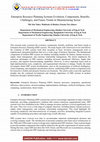
International Journal of All Research Education and Scientific Methods, 2020
This research study examines the evolution, components, benefits, problems, and future trends in ... more This research study examines the evolution, components, benefits, problems, and future trends in Enterprise Resource Planning (ERP) systems. The study begins with a historical review and follows the evolution of ERP systems from their inception as basic inventory management tools to sophisticated, integrated platforms that serve a wide range of business functions. The fundamental components of modern ERP systems are studied, including modules for finance, human resources, supply chain management, and customer relationship management. The article emphasizes the numerous advantages of ERP systems, including increased operational efficiency, higher data accuracy, and superior decision-making capabilities. However, it solves important issues such as high implementation costs, complexity, and organizational reluctance to change. Finally, the study investigates future ERP system developments, such as the incorporation of artificial intelligence, cloud computing, and expanded customisation choices, establishing ERP systems as important tools for tomorrow's nimble and dynamic business environments. This article seeks to provide significant insights into the continued development and strategic importance of ERP systems in modern businesses through a detailed analysis.
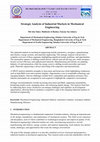
International Journal of Science and Research Archive, 2023
The industrial markets in mechanical engineering include automotive, aerospace, manufacturing and... more The industrial markets in mechanical engineering include automotive, aerospace, manufacturing and robotics, energy systems, and materials engineering. This strategic analysis will provide a complete overview of these segments, highlighting significant trends, problems, and opportunities. The automobile industry is shifting toward electric vehicles and self-driving cars, while aerospace focuses on fuel efficiency and sophisticated materials. Manufacturing and robotics are adopting Industry 4.0 and automation, while the energy sector is shifting toward renewables and smart grids. Materials engineering is always innovating with composites and nanomaterials. A SWOT analysis identifies strengths in innovation and broad uses while highlighting weaknesses such as high R&D costs and economic fragility. Opportunities exist in sustainable technology and emerging markets, whereas challenges include fierce competition and regulatory pressures. Key industry participants are recognized in each segment to highlight the competitive environment. Strategic recommendations include increasing innovation and R&D, supporting sustainability, broadening market reach, managing talent, and embracing digital change. This analysis finds that by addressing these issues, businesses can manage challenges and capitalize on development opportunities, allowing them to maintain a competitive edge in the changing industrial markets of mechanical engineering.
The Doherty Power Amplifier (DPA) is a pivotal component in modern wireless communication, offeri... more The Doherty Power Amplifier (DPA) is a pivotal component in modern wireless communication, offering enhanced efficiency and linearity. However, traditional DPAs face challenges related to harmonic distortion and power efficiency at back-off power levels. This paper presents an in-depth study on the optimization of harmonic injection networks (HINs) in DPAs to mitigate these issues. We propose a novel harmonic injection methodology that utilizes advanced network design techniques to improve performance metrics such as efficiency, linearity, and bandwidth. Experimental results demonstrate significant improvements in the overall performance of DPAs equipped with optimized HINs compared to conventional designs.
INTERNATIONAL JOURNAL OF PROGRESSIVE RESEARCH IN ENGINEERING MANAGEMENT AND SCIENCE, 2024
This study is comprehensive. It looks at how lean manufacturing concepts transform industrial pro... more This study is comprehensive. It looks at how lean manufacturing concepts transform industrial processes. They make them efficient and cut waste. The study uses real-time data to back up its findings. The Toyota Production System is rooted in lean manufacturing. It emphasizes creating value, cutting waste, and improving. The research delves into key lean principles. These include just-in-time production, value stream mapping, 5S, and Kaizen. It also covers their practical use in many industrial settings.

International Research Journal of Modernization in Engineering Technology and Science, 2024
In the rapidly changing landscape of the US manufacturing sector, optimizing production planning ... more In the rapidly changing landscape of the US manufacturing sector, optimizing production planning and inventory control has emerged as a vital aspect in maintaining competitiveness and profitability. This article studies the use of predictive analytics tools to improve production planning and inventory management procedures. Manufacturing companies may forecast demand trends, streamline production schedules, and manage inventory levels by combining historical data, real-time information, and complex analytical models. This paper uses a comprehensive evaluation of existing literature, as well as empirical data, to identify the possible benefits and obstacles of predictive analytics adoption in manufacturing settings. Case studies and empirical findings indicate predictive analytics' effectiveness in boosting production efficiency, reducing lead times, and lowering inventory costs. This study also examines the technological infrastructure needs, organizational competencies, and strategic considerations required for the successful implementation and integration of predictive analytics solutions. It also discusses potential challenges to adoption, such as data quality difficulties, organizational opposition, and resource restrictions, and provides recommendations for mitigation techniques. The outcomes of this study add to the body of knowledge about using predictive analytics for production planning and inventory control in the US industrial sector. Predictive analytics has the potential to provide manufacturing firms with a competitive advantage in today's quickly changing business environment by enabling data-driven decision-making and encouraging agility in response to market dynamics.
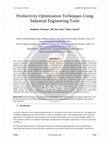
International Journal of Advance Research and Innovative Ideas in Education, 2024
This article investigates the use of industrial engineering tools and techniques to improve produ... more This article investigates the use of industrial engineering tools and techniques to improve productivity across a variety of industries. These techniques greatly increase operational performance by systematically eliminating inefficiencies and streamlining operations. Time and Motion Studies, Lean Manufacturing, and Six Sigma are three key methodologies presented for process analysis, waste reduction, and defect mitigation. Ergonomics and Just-In-Time (JIT) Production are highlighted for their contributions to employee well-being and inventory cost savings. Total Quality Management (TQM) and Workload Balancing guarantee that quality is embedded throughout the process and that work is distributed fairly. Supply Chain Optimization and Simulation Modeling are evaluated for their ability to improve logistics and process analysis. The effectiveness of project management techniques such as Gantt Charts, Critical Path Method (CPM), and Program Evaluation and Review Technique (PERT) in project planning and execution is described in detail. Benchmarking allows for a comparison approach to implementing industry best practices, whereas automation and robotics demonstrate the efficiency improvements from technology adoption. Finally, Data Analytics and Big Data are examined in terms of its predictive and analytical powers, which allow for more informed decision making. Collectively, these technologies create a solid foundation for attaining significant productivity gains. The combination of these strategies results in streamlined processes, less waste, higher quality, and greater adaptability in the face of changing industry needs. This extensive examination emphasizes the importance of industrial engineering in increasing productivity and operational excellence.

International Journal of Advance Research and Innovative Ideas in Education, 2024
Lean transformation in the US manufacturing industry aims to improve efficiency and competitivene... more Lean transformation in the US manufacturing industry aims to improve efficiency and competitiveness by reducing waste, implementing continuous improvement, and taking a customer-centric approach. However, various obstacles prevent the proper implementation of lean principles. This study identifies and tackles significant obstacles such as cultural resistance, insufficient training, mismatched organizational structures, and a lack of managerial commitment. Employees frequently perceive lean initiatives as threats to job security or an increase in workload, which leads to cultural resistance. Overcoming this requires cultivating a culture of trust, open communication, and integrating employees at all levels in the transformation process. Inadequate training is another important hurdle, as lean tools and processes require a thorough understanding to be effectively implemented. Investing in comprehensive and continuing training programs is critical to providing the workforce with the appropriate skills. Organizational structures that do not adhere to lean principles can impede transformation attempts. Realigning structures to encourage cross-functional collaboration and speed decision-making processes is critical. Furthermore, without strong management support, lean efforts may lose momentum and fail to persist. Leaders must provide unwavering support and actively participate in lean initiatives to inspire and drive change throughout the organization. This study focuses on best practices and tactics for overcoming these challenges, such as using change management approaches, creating pilot projects, and cultivating a culture of continuous improvement. By tackling these difficulties, US firms may increase efficiency, acquire a competitive advantage, and respond more quickly to market demands. The insights presented seek to help industry leaders navigate their lean transformation journeys successfully.
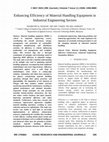
ICONIC RESEARCH AND ENGINEERING JOURNALS, 2024
Material handling equipment (MHE) is critical in industrial engineering sectors, coordinating the... more Material handling equipment (MHE) is critical in industrial engineering sectors, coordinating the smooth movement, storage, management, and protection of commodities throughout manufacturing and distribution activities. Its efficiency is critical, influencing productivity, cost management, and workplace safety. This research digs into a thorough examination of strategies and technology aimed at improving MHE efficiency in industrial settings. The study seeks to provide a detailed understanding of the multiple ways used in optimizing material handling equipment, encompassing both traditional methodologies and novel improvements. Efficiency enhancement options cover a wide range of methodologies, from classic to cutting-edge solutions. Automation and robots have emerged as key players, transforming material handling operations through their speed, precision, and dependability. The integration of IoT (Internet of Things) with data analytics enables real-time monitoring and predictive maintenance, resulting in optimal performance and minimal downtime. Ergonomic design principles not only promote smoother human-machine interactions, but they also reduce worker tiredness and injury hazards, improving operational efficiency and safety standards. Furthermore, using lean concepts and continuous improvement approaches simplifies material handling operations, resulting in waste reduction and process optimization. This study uses incisive case studies to shed light on successful implementations of efficiency enhancement measures, emphasizing the variables that contribute to their efficacy. Looking ahead, future trends and emerging technologies such as artificial intelligence and advanced robots have the potential to further transform material handling efficiency, highlighting the dynamic character of this vital area

INTERNATIONAL JOURNAL OF PROGRESSIVE RESEARCH IN ENGINEERING MANAGEMENT AND SCIENCE, 2024
Enterprise Resource Planning (ERP) systems are critical to the operational efficiency of the manu... more Enterprise Resource Planning (ERP) systems are critical to the operational efficiency of the manufacturing industry, but their deployment and use present numerous problems. This extensive investigation digs into the key challenges that manufacturing organizations face while implementing ERP systems. The main hurdles include high startup costs, complex integration with existing processes, and large time requirements for complete adoption. Furthermore, employee resistance to change, insufficient training, and the requirement for regular system updates make ERP installation difficult. Data security and system reliability are also key concerns. Furthermore, aligning ERP functionalities with specific manufacturing requirements frequently necessitates substantial customisation, resulting in potential delays and additional costs. The report emphasizes that, while ERP systems promise increased efficiency and streamlined operations, getting these benefits requires overcoming significant challenges. Effective management solutions, such as extensive planning, robust training programs, and stakeholder participation, are required to address these difficulties. This study emphasizes the need of addressing both technological and human elements to guarantee the successful implementation and long-term use of ERP systems in the industrial sector.
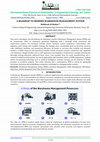
International Research Journal of Modernization in Engineering Technology and Science, 2024
This article investigates the full pathway for deploying a modern Warehouse Management System (WM... more This article investigates the full pathway for deploying a modern Warehouse Management System (WMS) and its revolutionary effect on warehouse operations. Beginning with a thorough needs assessment and requirement analysis, the technique includes vendor selection, system integration, customisation, data migration, pilot testing, and complete training. The findings show considerable gains in inventory accuracy, order fulfillment timelines, and operational efficiency, all thanks to real-time data visibility and advanced analytics. A WMS's financial and operational benefits include increased customer satisfaction and significant cost reductions. Despite hurdles such as staff opposition and integration complications, strategic planning and thorough training effectively addressed these issues. Case examples from the retail, manufacturing, and ecommerce industries demonstrate the broad applicability and beneficial effects of WMS deployment. Looking ahead, incorporating technology such as artificial intelligence, machine learning, and the Internet of Things promises to accelerate progress. This article indicates that a contemporary WMS is critical for optimizing warehouse operations and establishing a competitive advantage in a changing market scenario.
International Journal of Research Publication and Reviews, 2024
This research study investigates the revolutionary potential of modern technologies for industria... more This research study investigates the revolutionary potential of modern technologies for industrial manufacturing and supply chain risk management. It looks at how Industry 4.0 advancements like the Internet of Things (IoT), artificial intelligence (AI), blockchain, and robotics may improve operational efficiency, predictive maintenance, and supply chain transparency. The paper examines case studies and real-world applications to demonstrate how these technologies reduce risks, maximize resource allocation, and promote resilience to disturbance. By emphasizing the synergy between digital tools and traditional manufacturing processes, the paper presents a comprehensive framework for businesses looking to take a proactive and agile approach to risk management in an increasingly complex and linked global market.

Uploads
Papers by Mahboob Al Bashar